Ruth King Porter's Blog, page 2
September 18, 2011
Is The Score Even?
On a beautiful May evening last year, the beaver dam in Adamant village broke open letting a wall of water pour through the town. It destroyed the road and flooded the basement of a woman’s house, ruining her furnace. 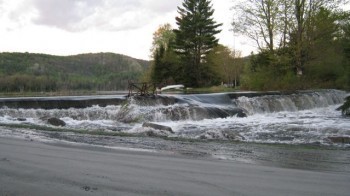
The Flooded Beaver Dam
There are two ponds, one on each side of the crossroads that is the center of the village of Adamant. On the south is Sodom Pond, a lake at the end of its life. Silt has built up until it is only about six feet deep. Some day in the not-too-distant future, it will be swampy, dry land. On the north side of the village is the Upper Pond, a wide expanse of water, for the most part, only a foot or two deep. It’s a pond at the beginning of its life. It used to be wetland, until the beaver built their dam. Even though it’s only a few feet deep, the water spreads out over about thirty-five acres. That means the beaver dam is holding back an enormous amount of water. An estimated two million gallons rushed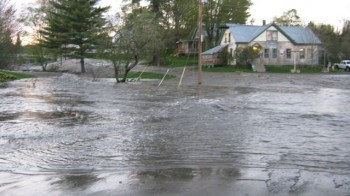
The Village After The Dam Broke
through the middle of town when the dam broke. The town road crew worked long hours to put the road back together, but the beaver worked even harder to rebuild their dam. For a few days they were all working side by side. There was talk about how the beaver should all be killed, even though more beaver would certainly move in to take their place. The people in the Agency of Natural Resources put two beaver baffles in the dam to keep the beaver from raising it as high as it had been before. Then at the end of August this year, Irene dumped a huge amount of water on Vermont, causing terrible floods and washed-out roads. But not in Adamant. The Upper Pond got very full.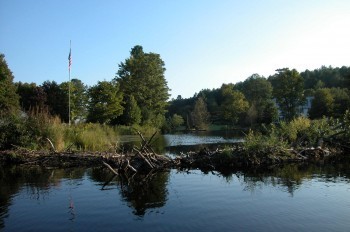
The Beaver Dam After Irene
Water poured over the beaver dam. Still, the dam held. Adamant was wet, but undamaged. Isn’t the score even now? Last year, the beaver caused damage to Adamant, but this year, their dam held back the water and protected Adamant. I think it’s one for one.September 4, 2011
A Week Later
It’s a steamy, overcast day, a week after Vermont’s disastrous floods. You might think we were back to summer, until you looked around. Then you see that the green is not so green, that there’s starting to be some yellow in the leaves and grass. The air seems different. The crows are gathering into groups. I haven’t seen a robin for days. Hurricane Irene blew us, or maybe washed us, into a new season, out of summer and into the beginning of fall.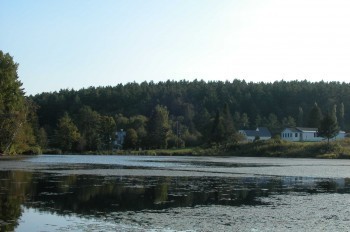
It’s supposed to rain hard tonight and tomorrow. I hope the weather people are wrong. It must be awful for people whose places got damaged by Irene to think they might get hit again. We were very lucky. The only damage we got was that there was a foot-deep gulley in the middle of our road, but it was passable if you straddled it with the wheels of the car. My corn got beaten down by the rain, but I was able to stand most of it up again.
The news is full of examples of how the people of Vermont are managing to cope with what has been thrown at them and how generous they are about turning out to help the ones who need help. It reminds me of the essay William Faulkner wrote called A Guest’s Impression Of New England. He says, “It is not the country which impressed this one. It is the people—the men and women themselves so individual, who hold individual integration and privacy as high and dear as they do liberty and freedom;” And later on in the essay he says about the New Englander, “Because he is free, private, not made so by the stern and rockbound land—the poor thin soil and the hard long winters—on which his lot was cast, but on the contrary: having elected of his own volition that stern land and weather because he knew he was tough enough to cope with them; having been bred by the long tradition which sent him from old worn-out Europe so he could be free; taught him to believe that there is no valid reason why life should be soft and docile and amenable, that to be individual and private is the thing and that the man who cannot cope with any environment anywhere had better not clutter the earth to begin with.”
It’s easy for me to say since I haven’t been hurt by the flood, but it’s still so. It was true in 1954 when Faulkner wrote it, and it’s still true today. And bravo to the tough people of our state.
July 1, 2011
Cutting Hay
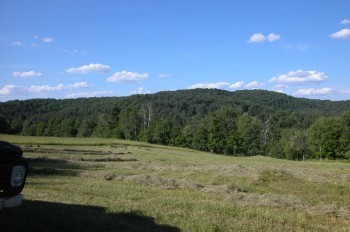
Cut hay
Of all the farm-related jobs we do in a year, getting the hay in is probably the most fun. It’s hard work, and it can be dangerous, but we need lots of hands to help, so it’s a social occasion too, an outdoor party with a guarantee of good weather, although there have been times when we were racing a thunderstorm.
Not very many people make hay the labor-intensive way we do any more. We use machines that are thirty or forty years old. We cut fields all around Adamant that our neighbors would like to keep open, and we haul the hay back to the barn in an old dump truck.
The weather is the tricky part, because to get the hay dry enough to be compressed into a bale and stacked in the barn, we need three days in a row that are sunny, or at least dry. It’s not easy to find that many days of good weather in a row in Vermont and especially not this year.
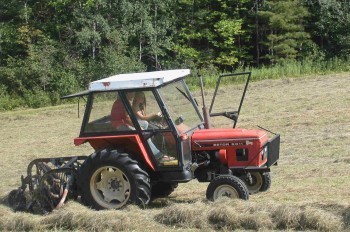
Raking
We started a couple of weeks ago with a very small piece of a field to see if the machinery was ready. It wasn’t. We had breakdowns, but we managed to put in 60 bales, before the weather changed. It was a very small beginning since we need 2000 for the winter.
The first two days of work are almost all Bill’s. He cuts the grass with a big machine that he pulls behind one of the tractors. After it has been cut, the hay has to lie in the field for a day. Bill drives over it pulling the tedder, a machine like a giant eggbeater that flips the hay and fluffs it up. The day after that Bill can rake the hay into long rows called windrows, so that the baler can pick it up and make it into bales.
Then the fun begins. The baler drops the bales all over the place. We drive the dump truck through the field throwing bales into it.

Loading the truck
Someone (I am usually the one) stacks them up into a huge interlocked pile that can stand the trip back to the barn. We can always get 80 or 90 bales into one load. Sometimes, if there are enough people who can throw that high, (and each bale weighs 40 or 50 pounds), or if we have enough time to fool around, we try to see how many we can get on a load. I think the most we ever did was 116. We take them back to the barn and unload them and stack them all over again. When all the hay is in, it feels wonderful to sit for a while and talk and laugh together.
This is the first of what I hope will be a series of blogs about my writing and my life on the farm, two things that are intertwined. They feed each other and enrich each other. My fiction comes out of my life in Vermont and my life has writing fiction at the center of it. There is a chapter in THE SIMPLE LIFE that tells how Sonny Trumbley and his family picked up the hay and put it in the barn.
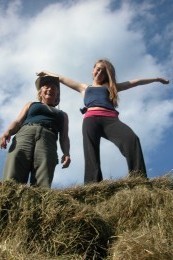
On top of the load



